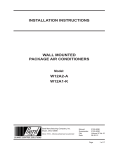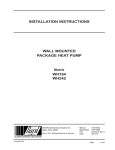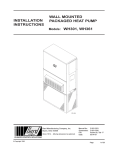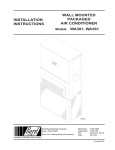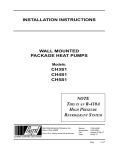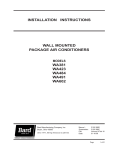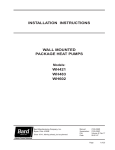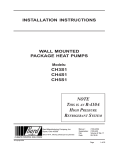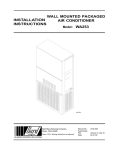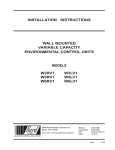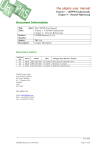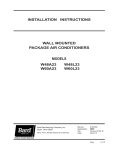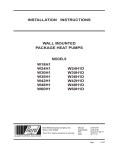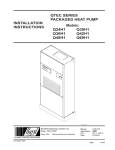Download Bard W38A1 Specifications
Transcript
INSTALLATION INSTRUCTIONS WALL MOUNTED PACKAGE AIR CONDITIONERS MODELS W38A1 W49A1 W61A1 Bard Manufacturing Company, Inc. Bryan, Ohio 43506 Since 1914...Moving ahead just as planned. Manual : Supersedes: File: Date: 2100-530A 2100-530 Volume III Tab 16 12-15-11 Manual Page 2100-530A 1 of 22 Contents Getting Other Information and Publications Wall Mount General Information Wall Mount Model Nomenclature ............................ Shipping Damage .................................................... General ................................................................ Duct Work ................................................................ Filters ................................................................ Fresh Air Intake ....................................................... Condensate Drain .................................................... 3 4 7 7 7 8 8 8 Installation Instructions Wall Mounting Information ....................................... 9 Mounting the Unit .................................................... 9 Wiring – Main Power ............................................. 14 Wiring – Low Voltage Wiring ................................. 14 Figures Figure 1 Figure 2 Figure 3 Figure 4 Figure 5 Figure 6 Figure 7 Figure 8 Figure 9 Figure 10 Figure 11 Unit Dimensions ...................................... 5 Fresh Air Damper Assembly ................... 8 Mounting Instructions ............................ 10 Electric Heat Clearance ......................... 11 Wall Mounting Instructions .................... 12 Wall Mounting Instructions .................... 12 Common Wall Mounting Installations .... 13 Fan Blade Setting ................................. 18 Control Disassembly ............................. 22 Winding Test ......................................... 22 Drip Loop .............................................. 22 Manual 2100-530A Page 2 of 22 Start Up R-410A / General ................................................... Topping off System Charge ................................... Safety Practices ..................................................... Important Installer Note ......................................... High Pressure Switch ............................................ Three Phase Scroll Compressor ............................ Phase Monitor ....................................................... Condenser Fan Operation ..................................... Service Hints ......................................................... Sequence of Operation .......................................... Compressor Control Module .................................. Adjustments ........................................................... Pressure Service Ports .......................................... 15 15 15 16 16 16 16 16 16 17 17 17 17 Troubleshooting Fan Blade Setting Dimensions .............................. 18 Removal of Fan Shroud ......................................... 18 Refrigerant Charge R-410A ................................... 18 Optional Accessories ............................................. 20 GE ECM™ Motors ......................................... 21 & 22 Tables Table 1 Table 2 Table 3 Table 4 Table 5 Table 6 Table 7 Electric Heat Table .................................. 4 Electrical Specifications .......................... 6 Fan Blade Dimensions .......................... 18 Pressures - Cooling .............................. 18 Indoor Blower Performance .................. 19 Heater Pkgs.-Field Installed .................. 19 Optional Accessories ............................ 20 GETTING OTHER INFORMATION AND PUBLICATIONS These publications can help you install the air conditioner or heat pump. You can usually find these at your local library or purchase them directly from the publisher. Be sure to consult current edition of each standard. FOR MORE INFORMATION, CONTACT THESE PUBLISHERS: ACCA Air Conditioning Contractors of America 1712 New Hampshire Ave. N.W. Washington, DC 20009 Telephone: (202) 483-9370 Fax: (202) 234-4721 ANSI American National Standards Institute 11 West Street, 13th Floor New York, NY 10036 Telephone: (212) 642-4900 Fax: (212) 302-1286 National Electrical Code ...................... ANSI/NFPA 70 Standard for the Installation .............. ANSI/NFPA 90A of Air Conditioning and Ventilating Systems Standard for Warm Air ...................... ANSI/NFPA 90B Heating and Air Conditioning Systems Load Calculation for ............................ ACCA Manual J Residential Winter and Summer Air Conditioning Duct Design for Residential .............. ACCA Manual D Winter and Summer Air Conditioning and Equipment Selection ASHRAE American Society of Heating, Refrigeration and Air Conditioning Engineers, Inc. 1791 Tullie Circle, N.E. Atlanta, GA 30329-2305 Telephone: (404) 636-8400 Fax: (404) 321-5478 NFPA National Fire Protection Association Batterymarch Park P.O. Box 9101 Quincy, MA 02269-9901 Telephone: (800) 344-3555 Fax: (617) 984-7057 Manufactured under the following U.S. Patent numbers: 5,485,878; 5,301,744 Manual 2100-530A Page 3 of 22 WALL MOUNT GENERAL INFORMATION AIR CONDITIONER WALL MOUNT MODEL NOMENCLATURE W 38 A 1 A REVISION SERIES CAPACITY | 38 - 3 Ton 49 - 4 Ton 61 - 5 Ton 10 X X X X COLOR OPTIONS X - Beige 1 - White 4 - Buckeye Gray 5 - Desert Brown 8 - Dark Bronze A - Aluminum S - Stainless Steel VENTILATION OPTIONS X - Barometric Fresh Air Damper (Standard) B - Blank-off Plate M - Motorized Fresh Air Damper V - Commercial Ventilator - Motorized with Exhaust E - Economizer (Internal) - Fully Modulating with Exhaust R - Energy Recovery Ventilator - Motorized with Exhaust P - Commercial Ventilator - Power Return with Exhaust X CONTROL MODULES (See Spec. Sheet S3412) KW VOLTS & PHASE A - 230/208/60/1 B - 230/208/60/3 C - 460/60/3 AIR CONDITIONER X COIL OPTIONS X - No Coating 1 - Phenolic Coated Evaporator 2 - Phenolic Coated Condenser 3 - Phenolic Coated Evaporator and Condenser OUTLET OPTIONS X - Front FILTER OPTIONS X - 1-Inch Fiberglass (MERV 2) H - 2-Inch Pleated (MERV 8) P - 2-Inch Pleated (MERV 6) W - 1-Inch Washable Note: For 0KW and circuit breakers (230/208 Volt) or rotary disconnect (460 Volt) applications, insert 0Z in the KW field of the model number. TABLE 1 ELECTRIC HEAT TABLE 230-1 W38A1-C W49A1-C W61A1-C W38A1-B W49A1-B W61A1-B W38A1-A W49A1-A W61A1-A Models 208-1 230-3 208-3 460-3 KW A B TU A B TU A B TU A B TU A B TU 5 20.8 17050 18.1 12800 --- --- --- --- --- --- 6 --- --- --- --- 14.4 20500 12.5 15360 7.2 20480 8 33.3 27280 28.8 20450 --- --- --- --- --- --- 9 --- --- --- --- 21.7 30600 18.7 23030 10.8 30700 10 41.6 34130 36.2 25600 --- --- --- --- --- --- 15 62.5 51200 54.0 38400 36.2 51200 31.2 38400 17.3 47000 Manual 2100-530A Page 4 of 22 Manual 2100-530A Page 5 of 22 G F 5.75 22.432 W61A1 42.075 RETURN C B E F G I J K L M N O P Q R S1 S2 T Front View High Voltage Electrical Entrance Low Voltage Electrical Entrance Ventilation Air Vent Option Door Filter Access Panel C. Breaker/ Disconnect Access Panel (Lockable) Electric Heat Heater Access Panel Built In Rain Hood 4° Pitch Side View Cond. Air Inlet D K Drain J C H I A 2.13 L N M Optional Electrical Entrances Top Rain Flashing Shipping Location Side Wall Mounting Brackets (Built In) P Q Back View .44 MIS-2762 T S2 S2 S1 S1 S1 R Bottom Installation Bracket Return Air Opening B Supply Air Opening O E 94.875 9.88 29.88 15.88 29.88 43.88 19.10 41.66 30.00 42.68 36.94 44.69 42.43 3.37 43.00 33.88 10.00 1.44 16.00 21.00 1.88 84.875 9.88 29.88 15.88 29.88 43.88 19.10 31.66 30.00 32.68 26.94 34.69 32.43 3.37 43.00 23.88 10.00 1.44 16.00 16.00 1.88 Condenser Air Outlet W 22.432 WIDTH DEPTH HEIGHT SUPPLY (W) (D) (H) A B W38A1 42.075 W49A1 MODEL Dimensions of Basic Unit for Architectural and I nstallation Requirements (Nominal) FIGURE 1 UNIT DIMENSIONS TABLE 2 ELECTRICAL SPECIFICATIONS Single Circuit Model W38A1 - A0Z A 05 A 08 A 10 A 15 W38A1 - B0Z B 06 B 09 B 15 W38A1 - C0Z C 06 C 09 C 15 W49A1 - A0Z 4 A 05 4 A 08 4 A 10 A 15 W49A1 - B0Z 4 B 06 B 09 4 B 15 W49A1 - C0Z 4 C 06 C 09 4 C 15 W61A1 - A0Z 4 A 05 4 A 08 4 A 10 A 15 W61A1- B0Z 4 B 06 4 B 09 B 15 W61A1 - C0Z 4 C 09 4 C 15 1 2 3 4 2 Rated No. Field 3 Minimum 1 Maximum 2 Field Circuit External Fuse Power Ground Volts Power Ampacity or Ckt. Brkr. Wire Size Wire and Phase Circuits 230/208-1 1 1 230/208-3 460-3 230/208-1 1 1 230/208-3 460-3 230/208-1 1 1 230/208-3 460-3 1 1 1 or 2 or 2 1 1 1 1 1 1 1 1 1 1 1 or 2 or 2 1 1 1 1 1 1 1 1 1 1 1 or 2 or 2 1 1 1 1 1 1 1 32 35 50 61 87 26 27 36 54 14 15 19 28 39 39 51 61 87 30 30 37 55 15 15 19 28 48 48 51 61 87 36 36 37 55 18 19 28 45 45 50 70 90 35 35 40 60 15 15 20 30 50 50 60 70 90 45 45 45 60 20 20 20 30 60 60 60 70 90 50 50 50 60 25 25 30 8 8 8 6 3 8 8 8 6 14 14 12 10 8 8 6 6 3 8 8 8 6 12 12 12 10 8 8 6 6 3 8 8 8 6 10 10 10 10 10 10 8 8 10 10 10 10 14 14 12 10 10 10 10 8 8 10 10 10 10 12 12 12 10 10 10 8 8 8 10 10 10 10 10 10 10 Dual Circuit 3 Minimum 1 Maximum 2 Field 2 Ground Circuit External Fuse Power Wire Size Ampacity or Ckt. Brkr. Wire Size Ckt. A Ckt. B Ckt. A Ckt. B Ckt. A Ckt. B Ckt. A Ckt. B 35 35 26 52 45 45 30 60 8 8 10 6 10 10 10 10 39 39 26 52 50 50 30 60 8 8 10 6 10 10 10 10 48 48 26 52 60 60 30 60 6 6 10 6 10 10 10 10 Maximum size of the time delay fuse or HACR type circuit breaker for protection of field wiring conductors. Based on 75°C copper wire. All wiring must conform to National Electrical Code and all local codes. These “Minimum Circuit Ampacity” values are to be used for sizing the field power conductors. Refer to the National Electric Code (latest revision), article 310 for power conductor sizing. These models are available with dehumidification with hot gas reheat. CAUTION: When more than one field power conductor circuit is run through one conduit, the conductors must be derated. Pay special attention to note 8 of table 310 of the National Electrical Code regarding Ampacity Adjustment Factors when more than 3 conductors are in a raceway. IMPORTANT: While this electrical data is presented as a guide, it is important to electrically connect properly sized fuses & conductor wires in accordance with the National Electrical Code & all local codes. Manual 2100-530A Page 6 of 22 SHIPPING DAMAGE DUCT WORK Upon receipt of equipment, the carton should be checked for external signs of shipping damage. If damage is found, the receiving party must contact the last carrier immediately, preferably in writing, requesting inspection by the carrier’s agent. All duct work, supply and return, must be properly sized for the design airflow requirement of the equipment. Air Conditioning Contractors of America (ACCA) is an excellent guide to proper sizing. All duct work or portions thereof not in the conditioned space should be properly insulated in order to both conserve energy and prevent condensation or moisture damage. GENERAL The equipment covered in this manual is to be installed by trained, experienced service and installation technicians. The refrigerant system is completely assembled and charged. All internal wiring is complete. The unit is designed for use with or without duct work. Flanges are provided for attaching the supply and return ducts. These instructions explain the recommended method to install the air cooled self-contained unit and the electrical wiring connections to the unit. These instructions and any instructions packaged with any separate equipment required to make up the entire air conditioning system should be carefully read before beginning the installation. Note particularly “Starting Procedure” and any tags and/or labels attached to the equipment. While these instructions are intended as a general recommended guide, they do not supersede any national and/or local codes in any way. Authorities having jurisdiction should be consulted before the installation is made. See Page 3 for information on codes and standards. Size of unit for a proposed installation should be based on heat loss calculation made according to methods of Air Conditioning Contractors of America (ACCA). The air duct should be installed in accordance with the Standards of the National Fire Protection Association for the Installation of Air Conditioning and Ventilating Systems of Other Than Residence Type, NFPA No. 90A, and Residence Type Warm Air Heating and Air Conditioning Systems, NFPA No. 90B. Where local regulations are at a variance with instructions, installer should adhere to local codes. ESP maximum static pressure is 0.50 for duct design. Design the duct work according to methods given by the Air Conditioning Contractors of America (ACCA). When duct runs through unheated spaces, it should be insulated with a minimum of one inch of insulation. Use insulation with a vapor barrier on the outside of the insulation. Flexible joints should be used to connect the duct work to the equipment in order to keep the noise transmission to a minimum. A 1/4 inch clearance to combustible material for the first three feet of duct attached to the outlet air frame is required. See Wall Mounting Instructions and Figures 3 and 4 for further details. Ducts through the walls must be insulated and all joints taped or sealed to prevent air or moisture entering the wall cavity. Some installations may not require any return air duct. A metallic return air grille is required with installations not requiring a return air duct. The spacing between louvers on the grille shall not be larger than 5/8 inch. Any grille that meets with 5/8 inch louver criteria may be used. It is recommended that Bard Return Air Grille Kit RG2 through RG5, or RFG2 through RFG5 be installed when no return duct is used. Contact distributor or factory for ordering information. If using a return air filter grille, filters must be of sufficient size to allow a maximum velocity of 400 fpm. NOTE: If no return air duct is used, applicable installation codes may limit this cabinet to installation only in a single story structure. Manual 2100-530A Page 7 of 22 FILTERS CONDENSATE DRAIN A 1-inch throwaway filter is supplied with each unit. The filter slides into position making it easy to service. This filter can be serviced from the outside by removing the service door. A 1-inch washable filter and 2-inch pleated filter are also available as optional accessories. The internal filter brackets are adjustable to accommodate the 2-inch filter by loosening two (2) screws on each bracket assembly and sliding the brackets apart to the required width and retightening the four (4) screws. A plastic drain hose extends from the drain pan at the top of the unit down to the unit base. There are openings in the unit base for the drain hose to pass through. In the event the drain hose is connected to a drain system of some type, it must be an open or vented type system to assure proper drainage. FRESH AIR INTAKE All units are built with fresh air inlet slots punched in the service door. If the unit is equipped with a fresh air damper assembly, the assembly is shipped already attached to the unit. The damper blade is locked in the closed position. To allow the damper to operate, the maximum and minimum blade position stops must be installed. See Figure 2. All capacity, efficiency and cost of operation information as required for Department of Energy “Energyguide” Fact Sheets is based upon the fresh air blank-off plate in place and is recommended for maximum energy efficiency. The blank-off plate is available upon request from the factory and is installed in place of the fresh air damper shipped with each unit. FIGURE 2 FRESH AIR DAMPER Manual 2100-530A Page 8 of 22 INSTALLATION INSTRUCTIONS WALL MOUNTING INFORMATION 1. Two holes for the supply and return air openings must be cut through the wall as shown in Figure 3. 2. On wood frame walls, the wall construction must be strong and rigid enough to carry the weight of the unit without transmitting any unit vibration. 3. Concrete block walls must be thoroughly inspected to insure that they are capable of carrying the weight of the installed unit. WARNING Failure to provide the 1/4 inch clearance between the supply duct and a combustible surface for the first 3 feet of duct can result in fire causing damage, injury or death. 4. Mount bottom mounting bracket. MOUNTING THE UNIT 1. These units are secured by wall mounting brackets which secure the unit to the outside wall surface at both sides. A bottom mounting bracket, attached to skid for shipping, is provided for ease of installation, but is not required. 2. The unit itself is suitable for 0 inch clearance, but the supply air duct flange and the first 3 feet of supply air duct require a minimum of 1/4 inch clearance to combustible material. If a combustible wall, use a minimum of 30½" x 10½" dimensions for sizing. However, it is generally recommended that a 1-inch clearance is used for ease of installation and maintaining the required clearance to combustible material. The supply air opening would then be 32" x 12". See Figures 3 and 4 for details. 3. Locate and mark lag bolt locations and bottom mounting bracket location. See Figure 3. 5. Hook top rain flashing, attached to front - right of supply flange for shipping, under back bend of top. Top rain flashing is shipped secured to the right side of the back. 6. Position unit in opening and secure with 5/16 lag bolts; use 7/8 inch diameter flat washers on the lag bolts. 7. Secure rain flashing to wall and caulk across entire length of top. See Figure 3. 8. For additional mounting rigidity, the return air and supply air frames or collars can be drilled and screwed or welded to the structural wall itself (depending upon wall construction). Be sure to observe required clearance if combustible wall. 9. On side-by-side installations, maintain a minimum of 20 inches clearance on right side to allow access to control panel and heat strips, and to allow proper airflow to the outdoor coil. Additional clearance may be required to meet local or national codes. Manual 2100-530A Page 9 of 22 Manual 2100-530A Page 10 of 22 7 18" 16" 16" 16" 16" 16" 1 1 4" Typ. 1 1 62" C 5 1/2 6 1/4 C 38" Dimension is 21" on 95" tall Units. 4" Typ. 1" 3" 30" Return Opening Supply Opening A 12 10 1/2 B Wall Opening and Hole Location View 1 1 62" 1 62" C 32 REQUIRED DIMENSIONS TO MAINTAIN RECOMMENDED 1" CLEARANCE FROM COMBUSTIBLE MATERIALS D 30 1/2 REQUIRED DIMENSIONS TO MAINTAIN 1/4" MIN. CLEARANCE FROM COMBUSTIBLE MATERIALS A 2 E 29 29 3/4 7 8" 28" 1 16" E B 1 1/4 D TOP HEATER ACCESS PANEL WALL SEAL WITH BEAD OF CAULKING ALONG ENTIRE LENGTH OF TOP. Right Side View MIS-416 D W**A UNIT SHOWN, W**L UNIT CONTROLS AND HEATER ACCESS IS ON OPPOSITE (LEFT) SIDE. IT IS RECOMMENDED THAT A BEAD OF SILICONE CAULKING BE PLACED BEHIND THE SIDE MOUNTING FLANGES AND UNDER TOP FLASHING AT TIME OF INSTALLATION. NOTES: RETURN AIR OPENING SUPPLY AIR DUCT 1/4" CLEARANCE ON ALL FOUR SIDES OF SUPPLY AIR DUCT IS REQUIRED FROM COMBUSTABLE MATERIALS WALL STRUCTURE FOAM AIR SEAL RAIN FLASHING SUPPLIED FIGURE 3 MOUNTING INSTRUCTIONS for W38A1, W49A1, W61A1 FIGURE 4 ELECTRIC HEAT CLEARANCE BELOW SIDE SECTION VIEW OF SUPPLY AIR DUCT FOR WALL MOUNTED UNIT SHOWING 1/4 INCH CLEARANCE TO COMBUSTIBLE SURFACES. WARNING A minimum of 1/4 inch clearance must be maintained between the supply air duct and combustible materials. This is required for the first 3 feet of ducting. It is important to insure that the 1/4 inch minimum spacing is maintained at all points. Failure to do this could result in overheating the combustible material and may result in a fire causing damage, injury or death. Manual 2100-530A Page 11 of 22 FIGURE 5 WALL MOUNTING INSTRUCTIONS SEE FIGURE 3 – MOUNTING INSTRUCTIONS FIGURE 6 WALL MOUNTING INSTRUCTIONS SEE UNIT DIMENSIONS, FIGURE 1, FOR ACTUAL DIMENSIONS Manual 2100-530A Page 12 of 22 FIGURE 7 COMMON WALL MOUNTING INSTALLATIONS Manual 2100-530A Page 13 of 22 WIRING – MAIN POWER WIRING – LOW VOLTAGE WIRING Refer to the unit rating plate for wire sizing information and maximum fuse or “HACR” type circuit breaker size. Each outdoor unit is marked with a “Minimum Circuit Ampacity”. This means that the field wiring used must be sized to carry that amount of current. Depending on the installed KW of electric heat, there may be two field power circuits required. If this is the case, the unit serial plate will so indicate. All models are suitable only for connection with copper wire. Each unit and/or wiring diagram will be marked “Use Copper Conductors Only”. These instructions must be adhered to. Refer to the National Electrical Code (NEC) for complete current carrying capacity data on the various insulation grades of wiring material. All wiring must conform to NEC and all local codes. 230/208V, 1 phase and 3 phase equipment dual primary voltage transformers. All equipment leaves the factory wired on 240V tap. For 208V operation, reconnect from 240V to 208V tap. The acceptable operating voltage range for the 240 and 208V taps are: The electrical data lists fuse and wire sizes (75° C copper) for all models including the most commonly used heater sizes. Also shown are the number of field power circuits required for the various models with heaters. The unit rating plate lists a “Maximum Time Delay Relay Fuse” or “HACR” type circuit breaker that is to be used with the equipment. The correct size must be used for proper circuit protection and also to assure that there will be no nuisance tripping due to the momentary high starting current of the compressor motor. The disconnect access door on this unit may be locked to prevent unauthorized access to the disconnect. To convert for the locking capability, bend the tab located in the bottom left-hand corner of the disconnect opening under the disconnect access panel straight out. This tab will now line up with the slot in the door. When shut, a padlock may be placed through the hole in the tab preventing entry. See “Start Up” section for important information on three phase scroll compressor start ups. See Table 2 for Electrical Specifications. Manual 2100-530A Page 14 of 22 TAP 240 208 RANGE 253 – 216 220 – 187 NOTE: The voltage should be measured at the field power connection point in the unit and while the unit is operating at full load (maximum amperage operating condition). For wiring size and connections, refer to Wiring Manual 2100-507. START UP THESE UNITS REQUIRE R-410A REFRIGERANT AND POLYOL ESTER OIL. REMEMBER: When adding R-410A refrigerant, it must come out of the charging cylinder/tank as a liquid to avoid any fractionation, and to insure optimal system performance. Refer to instructions for the cylinder that is being utilized for proper method of liquid extraction. GENERAL: 1. Use separate service equipment to avoid cross contamination of oil and refrigerants. 2. Use recovery equipment rated for R-410A refrigerant. 3. Use manifold gauges rated for R-410A (800 psi/250 psi low). WARNING Failure to conform to these practices could lead to damage, injury or death. 4. R-410A is a binary blend of HFC-32 and HFC-125. 5. R-410A is nearly azeotropic - similar to R-22 and R-12. Although nearly azeotropic, charge with liquid refrigerant. 6. R-410A operates at 40-70% higher pressure than R-22, and systems designed for R-22 cannot withstand this higher pressure. 7. R-410A has an ozone depletion potential of zero, but must be reclaimed due to its global warming potential. 8. R-410A compressors use polyolester oil. 9. Polyol Ester oil is hygroscopic; it will rapidly absorb moisture and strongly hold this moisture in the oil. 10. A liquid line dryer must be used - even a deep vacuum will not separate moisture from the oil. 11. Limit atmospheric exposure to 15 minutes. 12. If compressor removal is necessary, always plug compressor immediately after removal. Purge with small amount of nitrogen when inserting plugs. TOPPING OFF SYSTEM CHARGE If a leak has occurred in the system, Bard Manufacturing recommends reclaiming, evacuating (see criteria above), and charging to the nameplate charge. If done correctly, topping off the system charge can be done without problems. With R-410A, there are no significant changes in the refrigerant composition during multiple leaks and recharges. R-410A refrigerant is close to being an azeotropic blend (it behaves like a pure compound or single component refrigerant). The remaining refrigerant charge, in the system, may be used after leaks have occurred and then “top-off” the charge by utilizing the pressure charts on the inner control panel cover as a guideline. SAFETY PRACTICES: 1. Never mix R-410A with other refrigerants. 2. Use gloves and safety glasses, Polyol Ester oils can be irritating to the skin, and liquid refrigerant will freeze the skin. 3. Never use air and R-410A to leak check; the mixture may become flammable. 4. Do not inhale R-410A – the vapor attacks the nervous system, creating dizziness, loss of coordination and slurred speech. Cardiac irregularities, unconsciousness and ultimate death can result from breathing this concentration. 5. Do not burn R-410A. This decomposition produces hazardous vapors. Evacuate the area if exposed. 6. Use only cylinders rated DOT4BA/4BW 400. 7. Never fill cylinders over 80% of total capacity. 8. Store cylinders in a cool area, out of direct sunlight. 9. Never heat cylinders above 125°F. 10. Never trap liquid R-410A in manifold sets, gauge lines or cylinders. R-410A expands significantly at warmer temperatures. Once a cylinder or line is full of liquid, any further rise in temperature will cause it to burst. Manual 2100-530A Page 15 of 22 START UP IMPORTANT INSTALLER NOTE PHASE MONITOR For improved start up performance wash the indoor coil with a dish washing detergent. All units with three phase scroll compressors are equipped with a 3 phase line monitor to prevent compressor damage due to phase reversal. HIGH PRESSURE SWITCH The W38A1, W49A1 and W61A1 models are supplied with a remote reset high pressure switch. If tripped, this pressure switch may be reset by turning the thermostat off then back on again. THREE PHASE SCROLL COMPRESSOR START UP INFORMATION Scroll compressors, like several other types of compressors, will only compress in one rotational direction. Direction of rotation is not an issue with single phase compressors since they will always start and run in the proper direction. However, three phase compressors will rotate in either direction depending upon phasing of the power. Since there is a 50-50 chance of connecting power in such a way as to cause rotation in the reverse direction, verification of proper rotation must be made. Verification of proper rotation direction is made by observing that suction pressure drops and discharge pressure rises when the compressor is energized. Reverse rotation also results in an elevated sound level over that with correct rotation, as well as, substantially reduced current draw compared to tabulated values. Verification of proper rotation must be made at the time the equipment is put into service. If improper rotation is corrected at this time, there will be no negative impact on the durability of the compressor. However, reverse operation for over one hour may have a negative impact on the bearing due to oil pump out. NOTE: If compressor is allowed to run in reverse rotation for several minutes, the compressor’s internal protector will trip. All three phase ZR compressors are wired identically internally. As a result, once the correct phasing is determined for a specific system or installation, connecting properly phased power leads to the same Fusite terminal should maintain proper rotation direction. The direction of rotation of the compressor may be changed by reversing any two line connections to the unit. Manual 2100-530A Page 16 of 22 The phase monitor in this unit is equipped with two LEDs. If the Y signal is present at the phase monitor and phases are correct the green LED will light. If phases are reversed, the red fault LED will be lit and compressor operation is inhibited. If a fault condition occurs, reverse two of the supply leads to the unit. Do not reverse any of the unit factory wires as damage may occur. CONDENSER FAN OPERATION The condenser fan motor on 230/208 volt, one and three phase, 60 HZ units is a two-speed motor that comes factory wired on high speed for peak performance. If ambient conditions permit, it can be reconnected to low speed (red wire) for lower sound level. See wiring diagram. 50 HZ models must have fan wired on low speed. These models are factory wired on low speed. SERVICE HINTS 1. Caution owner/operator to maintain clean air filters at all times. Also, not to needlessly close off supply and return air registers. This reduces airflow through the system, which shortens equipment service life as well as increasing operating costs. 2. Check all power fuses or circuit breakers to be sure they are the correct rating. 3. Periodic cleaning of the outdoor coil to permit full and unrestricted airflow circulation is essential. SEQUENCE OF OPERATION Alarm Relay Output COOLING – Circuit R-Y makes at thermostat pulling in compressor contactor, starting the compressor and outdoor motor. The G (indoor motor) circuit is automatically completed on any call for cooling operation or can be energized by manual fan switch on subbase for constant air circulation. On a call for heating, circuit R-W1 make at the thermostat pulling in heat contact for the strip heat and blower operation. On a call for second stage heat, R-W2 makes bringing on second heat contactor, if so equipped. Alarm terminal is output connection for applications where alarm relay is employed. This terminal is powered whenever the compressor is locked out due to HPC or LPC sequences as described. COMPRESSOR CONTROL MODULE The compressor control module is standard on all models covered by this manual. The compressor control module is an anti-short cycle/lockout timer with high and low pressure switch monitoring and alarm relay output. Adjustable Delay On Make And Break Timer On initial power up or anytime power is interrupted to the unit, the delay on make period begins, which will be 2 minutes plus 10% of the delay on break setting. When the delay on make is complete and the high pressure switch and low pressure switch is closed, the compressor contactor is energized. Upon shutdown, the delay on break timer starts and prevents restart until the delay on break and delay on make periods have expired. During routine operation of the unit with no power interruptions, the compressor will operate on demand with no delay. High Pressure Switch and Lockout Sequence If the high pressure switch opens, the compressor contactor will de-energize immediately. The lockout timer will go into a soft lockout and stay in soft lockout until the high pressure switch closes and the delay on break time has expired. If the high pressure switch opens again in this same operating cycle, the unit will go into manual lockout condition and the alarm relay circuit will energize. Recycling the wall thermostat resets the manual lockout. Low Pressure Switch, Bypass, and Lockout Sequence NOTE: Both high and low pressure switch controls are inherently automatic reset devices. The high pressure switch and low pressure switch cut out and cut in settings are fixed by specific air conditioner unit model. The lockout features, both soft and manual, are a function of the Compressor Control Module. ADJUSTMENTS Adjustable Delay on Make and Delay on Break Timer The potentiometer is used to select Delay on Break time from 30 seconds to 5 minutes. Delay on Make (DOM) timing on power-up and after power interruptions is equal to 2 minutes plus 10% of Delay on Break (DOB) setting: 0.5 minute 1.0 minute 2.0 minute 3.0 minute 4.0 minute 5.0 minute (30 seconds) (60 seconds) (120 seconds) (180 seconds) (240 seconds) (300 seconds) DOB = 123 DOB = 126 DOB = 132 DOB = 138 DOB = 144 DOB = 150 second DOM second DOM second DOM second DOM second DOM second DOM During routine operation of the unit with no power interruptions the compressor will operate on demand with no delay. Typical Settings for Dual Unit Installation: Unit 1: DOB set at 2 minutes, and DOM is 132 seconds Unit 2: DOB set at 4 minutes, and DOM is 144 seconds PRESSURE SERVICE PORTS High and low pressure service ports are installed on all units so that the system operating pressures can be observed. A pressure table can be found later in the manual covering all models. It is imperative to match the correct pressure table to the unit by model number. If the low pressure switch opens for more than 120 seconds, the compressor contactor will de-energize and go into a soft lockout. Regardless the state of the low pressure switch, the contactor will reenergize after the delay on make time delay has expired. If the low pressure switch remains open, or opens again for longer than 120 seconds, the unit will go into manual lockout condition and the alarm relay circuit will energize. Recycling the wall thermostat resets the manual lockout. Manual 2100-530A Page 17 of 22 TROUBLESHOOTING REMOVAL OF FAN SHROUD FAN BLADE SETTING DIMENSIONS Shown in Figure 8 is the correct fan blade setting dimension for proper air delivery across the outdoor coil. Any service work requiring removal or adjustment in the fan and/or motor area will require that the dimensions below be checked and blade adjusted in or out on the motor shaft accordingly. FIGURE 8 FAN BLADE SETTING 1. Disconnect all power to the unit. 2. Remove the screws holding both grilles, one on each side of unit, and remove grilles. 3. Remove screws holding fan shroud to condenser and bottom. Nine (9) screws. 4. Unwire condenser fan motor. 5. Slide complete motor, fan blade, and shroud assembly out the left side of the unit. 6. Service motor/fan as needed. 7. Reverse steps to reinstall. R-410A REFRIGERANT CHARGE TABLE 3 FAN BLADE DIMENSION Model Dimension A W38A1 W49A1 W61A1 1.75" MIS-1724 This unit was charged at the factory with the quantity of refrigerant listed on the serial plate. AHRI capacity and efficiency ratings were determined by testing with this refrigerant charge quantity. The following pressure tables show nominal pressures for the units. Since many installation specific situations can affect the pressure readings, this information should only be used by certified technicians as a guide for evaluating proper system performance. They shall not be used to adjust charge. If charge is in doubt, reclaim, evacuate and recharge the unit to the serial plate charge. TABLE 4 COOLING PRESSURE — (ALL TEMPERATURES IN DEGREES F) R E TU R N AIR MODEL TEMP. PRESSURE W38A1 W49A1 W61A1 AIR TEMPERATURE ENTERING OUTDOOR COIL 75 80 85 90 95 100 105 110 115 75 D B 62 WB Low S i de High Side 118 319 121 338 122 360 124 383 126 408 128 434 130 461 131 489 133 520 80 D B 67 WB Low S i de High Side 126 327 129 347 131 369 133 393 134 418 137 445 139 473 140 502 142 533 85 D B 72 WB Low S i de High Side 130 338 134 359 136 382 138 407 140 433 142 461 144 490 145 520 147 552 75 D B 62 WB Low S i de High Side 125 335 126 358 126 381 127 405 128 430 130 455 133 482 136 508 140 536 80 D B 67 WB Low S i de High Side 134 344 135 367 135 391 136 415 140 439 140 467 142 494 145 521 150 550 85 D B 72 WB Low S i de High Side 139 356 140 380 140 405 141 430 142 456 144 483 147 511 150 539 155 569 75 D B 62 WB Low S i de High Side 115 345 116 363 118 382 119 403 121 426 122 450 124 476 126 504 128 533 80 D B 67 WB Low S i de High Side 123 354 124 372 126 392 127 413 131 415 131 462 133 488 135 517 137 547 85 D B 72 WB Low S i de High Side 127 366 128 385 130 406 131 427 134 452 136 478 138 505 140 535 142 566 Low side pressure ± 4 psig High side pressure ± 10 psig Tables are based upon rated CFM (airflow) across the evaporator coil. If there is any doubt as to correct operating charge being in the system, the charge should be removed, system evacuated and recharged to serial plate instructions. Manual 2100-530A Page 18 of 22 TABLE 5 INDOOR BLOWER PERFORMANCE CFM (0.00" – 0.50" H2O) 1 NOTE: Model Rated ESP 1 Max ESP 2 Blow er Only 3 Cooling 4 Electric H eat W38A .15 .50 1100 1100 1100 W49A .20 .50 1400 1400 1400 W61A .20 .50 1450 1450 1450 These units are equipped with a variable speed (ECM) indoor motor that automatically adjusts itself to maintain approximately the same rate of indoor airflow in both heating & cooling, dry & wet coil conditions and at both 230/208 or 460 volts. 1 Maximum ESP (inches WC) shown is with 2" thick disposable filter. 2 Blower only CFM is the total air being circulated during continuous fan mode. 3 CFM output on Cooling or Electric Heat. TABLE 6 HEATER PACKAGES - FIELD INSTALLED • Designed for adding Electric Heat to 0 KW Units • Circuit Breaker Standard on 230/208V Models Air Conditioner Models W38A1 W49A1 W61A1 -A00 Models 230/208-1 Heater Model # EHS03A-A05 EHS03A-A08 EHS03A-A10 EHS03A-A15 EHS04A-A05 EHS04A-A08 EHS03A-A10 EHS04A-A15 EHS05A-A05 EHS04A-A08 EHS05A-A10 EHS05A-A15 KW 5 8 10 15 5 8 10 15 5 8 10 15 • ETL US & Canada Listed • Rotary Disconnect Standard on 460V Models -B00 Models 230/208-3 Heater Model # KW -C00 Models 460-3 Heater Model # KW EHS03A-B06 EHS03A-B09 EHS03A-B15 6 9 15 EHS03A-C06 EHS03A-C09 EHS03A-C15 6 9 15 EHS03A-B06 EHS04A-B09 EHS04A-B15 6 9 15 EHS03A-C06 EHS04A-C09 EHS04A-C15 6 9 15 EHS04A-B09 EHS04A-B15 9 15 EHS04A-C09 EHS04A-C15 9 15 Manual 2100-530A Page 19 of 22 NOTE: Part Number Description W38A1-A W38A1-B W38A1-C W49A1-A W49A1-B W49A1-C W61A1-A W61A1-B W61A1-C TABLE 7 OPTIONAL ACCESSORIES BOP-5 BFAD-5 MFAD-5 Blank Off Plate Barometric Fresh Air Damper Motorized Fresh Air Damper X X X X X X X X X X X X X X X X X X X X X X X X X X X CRVS-5 CRVS-5 EIFM-5C ERVF-A3-* ERVF-C3-* Commercial Ventilator w/Exhaust - Spring Return Commercial Ventilator w/Exhaust - Power Return Economizer with Exhaust Energy Recovery Ventilator (230V) Energy Recovery Ventilator (460V) X X X X X X X X X X X X X X X X X X X X X X X X X X X X X X X X X CMA-28 Low Ambient Control (LAC) X X X X X X X X X CMA-14 Outdoor Thermostat X X X X X X X X X WMCB-07A WMCB-05B WMCB-08A WMCB-07B WMCB-09A WMCB-08B WMRD-01C Circuit Breaker Kit Circuit Breaker Kit Circuit Breaker Kit Circuit Breaker Kit Circuit Breaker Kit Circuit Breaker Kit Rotary Disconnect Kit X Color option must be specified to match units. Manual 2100-530A Page 20 of 22 X X X X X X X X X X X TROUBLESHOOTING GE ECM™ MOTORS CAUTION: Symptom Cause/Procedure Disconnect power from unit before removing or replacing connectors, or servicing motor. To avoid electric shock from the motor’s capacitors, disconnect power and wait at least 5 minutes before opening motor. • Noisy blower or cabinet • Check for loose blower housing, panels, etc. • High static creating high blower speed? - Check for air whistling through seams in ducts, cabinets or panels - Check for cabinet/duct deformation Symptom Cause/Procedure Motor rocks slightly when starting • This is normal start-up for ECM • “Hunts” or “puffs” at high CFM (speed) • Does removing panel or filter reduce “puffing”? - Reduce restriction - Reduce max. airflow Motor won’t start • No movement • Check blower turns by hand • Check power at motor • Check low voltage (24 Vac R to C) at motor • Check low voltage connections (G, Y, W, R, C) at motor • Check for unseated pins in connectors on motor harness • Test with a temporary jumper between R - G • Check motor for tight shaft • Perform motor/control replacement check • Perform Moisture Check • Motor rocks, but won’t start Motor oscillates up load & down while being tested off of blower Motor starts, but runs erratically • Varies up and down or intermittent • Check for loose or compliant motor mount • Make sure blower wheel is tight on shaft • Perform motor/control replacement check • It is normal for motor to oscillate with no on shaft • Check line voltage for variation or “sag” • Check low voltage connections (G, Y, W, R, C) at motor, unseated pins in motor harness connectors • Check “Bk” for erratic CFM command (in variable-speed applications) • Check out system controls, Thermostat • Perform Moisture Check Evidence of Moisture • Motor failure or Check malfunction has occurred and moisture is present • Evidence of moisture present inside air mover • Perform Moisture Check Do Don’t • Check out motor, controls, wiring and connections thoroughly before replacing motor • Orient connectors down so water can’t get in - Install “drip loops” • Use authorized motor and model #’s for replacement • Keep static pressure to a minimum: - Recommend high efficiency, low static filters - Recommend keeping filters clean. - Design ductwork for min. static, max. comfort - Look for and recommend ductwork improvement, where necessary • Automatically assume the motor is bad. • “Hunts” or “puffs” at high CFM (speed) • Does removing panel or filter reduce “puffing”? - Reduce restriction - Reduce max airflow • Size the equipment wisely • Stays at low CFM despite system call for cool or heat CFM • Check low voltage (Thermostat) wires and connections • Verify fan is not in delay mode; wait until delay complete • “R” missing/not connected at motor • Perform motor/control replacement check Moisture Check • Stays at high CFM • “R” missing/not connected at motor • Is fan in delay mode? - wait until delay time complete • Perform motor/control replacement check • Blower won’t shut off • Current leakage from controls into G, Y or W? Check for Triac switched thermostat or solidstate relay Excessive noise • Determine if it’s air noise, cabinet, duct or motor noise; interview customer, if necessary • High static creating high blower speed? - Is airflow set properly? - Does removing filter cause blower to slow down? Check filter - Use low-pressure drop filter - Check/correct duct restrictions • Air noise • Replace motor and Perform Moisture • Locate connectors above 7 and 4 o’clock positions • Replace one motor or control model # with another (unless an authorized replacement) • Use high pressure drop filters some have ½" H20 drop! • Use restricted returns • Oversize system, then compensate with low airflow • Check orientation before • Plug in power connector backwards inserting motor connectors • Force plugs • Connectors are oriented “down” (or as recommended by equipment manufacturer) • Arrange harness with “drip loop” under motor • Is condensate drain plugged? • Check for low airflow (too much latent capacity) • Check for undercharged condition • Check and plug leaks in return ducts, cabinet Comfort Check • Check proper airflow settings • Low static pressure for lowest noise • Set low continuous-fan CFM • Use humidistat and 2-speed cooling units • Use zoning controls designed for ECM that regulate CFM • Thermostat in bad location? Manual 2100-530A Page 21 of 22 TROUBLESHOOTING GE ECM™ MOTORS CONT’D. Replacing ECM Control Module To replace the control module for the GE variable-speed indoor blower motor you need to take the following steps: 1. You MUST have the correct replacement module. The controls are factory programmed for specific operating modes. Even though they look alike, different modules may have completely different functionality. USING THE WRONG CONTROL MODULE VOIDS ALL PRODUCT WARRANTIES AND MAY PRODUCE UNEXPECTED RESULTS. 2. Begin by removing AC power from the furnace or air handler being serviced. DO NOT WORK ON THE MOTOR WITH AC POWER APPLIED. To avoid electric shock from the motor’s capacitors, disconnect power and wait at least 5 minutes before opening motor. 3. It is usually not necessary to remove the motor from the blower assembly. However, it is recommended that the whole blower assembly, with the motor, be removed from the furnace/air handler. (Follow the manufacturer’s procedures). Unplug the two cable connectors to the motor. There are latches on each connector. DO NOT PULL ON THE WIRES. The plugs remove easily when properly released. 4. Locate the two standard ¼" hex head bolts at the rear of the control housing (at the back end of the control opposite the shaft end). Refer to Figure 9. Remove these two bolts from the motor and control assembly while holding the motor in a way that will prevent the motor or control from falling when the bolts are removed. If an ECM2.0 control is being replaced (recognized by an aluminum casting rather that a deep-drawn black steel can housing the electronics), remove only the hex-head bolts. DO NOT REMOVE THE TORX-HEAD SCREWS. 5. The control module is now free of mechanical attachment to the motor endshield but is still connected by a plug and three wires inside the control. Carefully rotate the control to gain access to the plug at the control end of the wires. With thumb and forefinger, reach the latch holding the plug to the control and release it by squeezing the latch tab and the opposite side of the connector plug and gently pulling the plug out of the connector socket in the control. DO NOT PULL ON THE WIRES. GRIP THE PLUG ONLY. 6. The control module is now completely detached from the motor. Verify with a standard ohmmeter that the resistance from each motor lead (in the motor plug just removed) to the motor shell is >100K ohms. Refer to Figure 10. (Measure to unpainted motor end plate.) If any motor lead fails this test, do not proceed to install the control module. THE MOTOR IS DEFECTIVE AND MUST BE REPLACED. Installing the new control module will cause it to fail also. 7. Verify that the replacement control is correct for your application. Refer to the manufacturer's authorized replacement list. USING THE WRONG CONTROL WILL RESULT IN IMPROPER OR NO BLOWER OPERATION. Orient the control module so that the 3wire motor plug can be inserted into the socket in the control. Carefully insert the plug and press it into the socket until it latches. A SLIGHT CLICK WILL BE HEARD WHEN PROPERLY INSERTED. Finish installing the replacement control per one of the three following paragraphs, 8a, 8b or 8c. 8a. IF REPLACING AN ECM 2.0 CONTROL (control in cast aluminum can with air vents on the back of the can) WITH AN ECM 2.3 CONTROL (control containing black potting for water protection in black deep-drawn steel case with no vents in the bottom of the can), locate the two through-bolts and plastic tab that are packed with the replacement control. Insert the plastic tab into the slot at the perimeter of the open end of the can so that the pin is located on the inside of the perimeter of the can. Rotate the can so that the tab inserts into the tab locater hole in the endshield of the motor. Using the two through-bolts provided with the replacement control, reattach the can to the motor. THE TWO THROUGH-BOLTS PROVIDED WITH THE REPLACEMENT ECM 2.3 CONTROL ARE SHORTER THAN THE BOLTS ORIGINALLY REMOVED FROM THE ECM 2.0 CONTROL AND MUST BE USED IF SECURE ATTACHMENT OF THE CONTROL TO THE MOTOR IS TO BE ACHIEVED. DO NOT OVERTIGHTEN THE BOLTS. Manual 2100-530A Page 22 of 22 8b. IF REPLACING AN ECM 2.3 CONTROL WITH AN ECM 2.3 CONTROL, the plastic tab and shorter through-bolts are not needed. The control can be oriented in two positions 180° apart. MAKE SURE THE ORIENTATION YOU SELECT FOR REPLACING THE CONTROL ASSURES THE CONTROL'S CABLE CONNECTORS WILL BE LOCATED DOWNWARD IN THE APPLICATION SO THAT WATER CANNOT RUN DOWN THE CABLES AND INTO THE CONTROL. Simply orient the new control to the motor's endshield, insert bolts, and tighten. DO NOT OVERTIGHTEN THE BOLTS. 8c. IF REPLACING AN ECM 2.0 CONTROL WITH AN ECM 2.0 CONTROL (It is recommended that ECM 2.3 controls be used for all replacements), the new control must be attached to the motor using through bolts identical to those removed with the original control. DO NOT OVERTIGHTEN THE BOLTS. 9. Reinstall the blower/motor assembly into the HVAC equipment. Follow the manufacturer's suggested procedures. 10. Plug the 16-pin control plug into the motor. The plug is keyed. Make sure the connector is properly seated and latched. 11. Plug the 5-pin power connector into the motor. Even though the plug is keyed, OBSERVE THE PROPER ORIENTATION. DO NOT FORCE THE CONNECTOR. It plugs in very easily when properly oriented. REVERSING THIS PLUG WILL CAUSE IMMEDIATE FAILURE OF THE CONTROL MODULE. 12. Final installation check. Make sure the motor is installed as follows: a. Unit is as far INTO the blower housing as possible. b.Belly bands are not on the control module or covering vent holes. c. Motor connectors should be oriented between the 4 o’clock and 8 o’clock positions when the blower is positioned in its final location and orientation. d.Add a drip loop to the cables so that water cannot enter the motor by draining down the cables. Refer to Figure 11. The installation is now complete. Reapply the AC power to the HVAC equipment and verify that the new motor control module is working properly. Follow the manufacturer's procedures for disposition of the old control module. Figure 410 Figure Winding Test Figure 9 3 Control Disassembly Motor Connector (3-pin) Only remove From Motor Hex Head Bolts Push until Latch Seats Over Ramp Circuit Board Motor ECM 2.0 Motor OK when R > 100k ohm Note: Use the shorter bolts and alignment pin supplied when replacing an ECM 2.0 control. Figure Figure11 5 Drip Loop ECM 2.3/2.5 Motor Connector (3-pin) Back of Control Connector Orientation Between 4 and 8 o'clock Control Connector (16-pin) Power Connector (5-pin) Hex-head Screws Drip Loop






















